

Compact Muon Solenoid
LHC, CERN
| CMS-PAS-B2G-20-008 | ||
| Search for weak vector boson and gluon-gluon fusion production of heavy resonances decaying to Z(νˉν)Vqq | ||
| CMS Collaboration | ||
| March 2021 | ||
| Abstract: A search is presented for heavy bosons decaying to Z(νˉν)Vqq, where V can either be a Z or a W boson. A sample of proton-proton collisions at √s= 13 TeV were collected by the CMS experiment during 2016, 2017, and 2018. The data correspond to an integrated luminosity of 137 fb−1. Events are categorized using substructure techniques and the presence of large missing transverse momentum to identify W and Z bosons decaying to quarks and neutrinos, respectively. Events are also categorized based on the presence of high-momentum jets in the forward region to identify production through weak vector boson fusion. The dominant standard model backgrounds are estimated using data taken from control regions. The data are interpreted in terms of radions, W' bosons, and gravitons, all under the assumption that these bosons are produced in gluon-gluon fusion, qˉq-annihilation, or weak vector boson fusion processes. No evidence is found for physics beyond the standard model, and 95% confidence level upper limits are set on various types of hypothetical new bosons. Exclusion limits on the masses of these bosons range from 1.2 TeV to 4.0 TeV. | ||
|
Links:
CDS record (PDF) ;
inSPIRE record ;
CADI line (restricted) ;
These preliminary results are superseded in this paper, Submitted to PRD. The superseded preliminary plots can be found here. |
||
| Figures | |
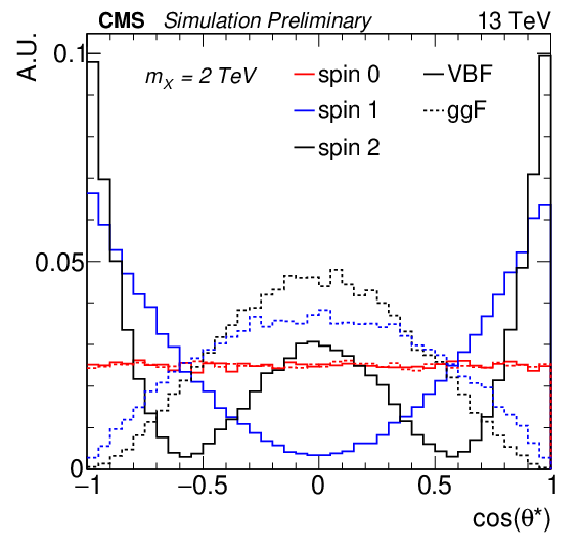
png pdf |
Figure 1:
Distributions are shown for the decay angle of SM vector bosons in the rest frame of their parent particle. Solid lines represent VBF scenarios. Dashed lines represent ggF scenarios. |
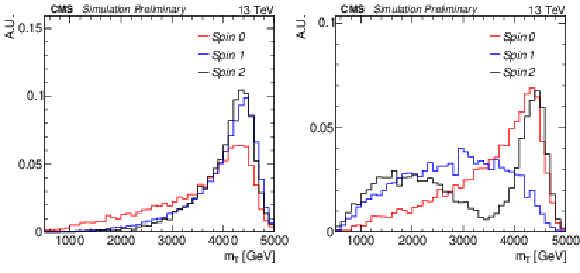
png pdf |
Figure 2:
Distributions of mT for ggF- (left) and VBF-produced (right) resonances. |

png pdf |
Figure 2-a:
Distributions of mT for ggF- (left) and VBF-produced (right) resonances. |
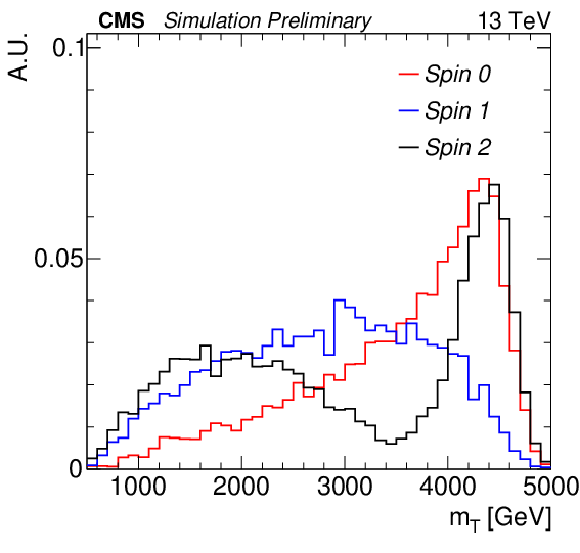
png pdf |
Figure 2-b:
Distributions of mT for ggF- (left) and VBF-produced (right) resonances. |

png pdf |
Figure 3:
The distributions of α versus mT in the various event categories are shown. The last bin corresponds to the value obtained by integrating events above the penultimate bin. |
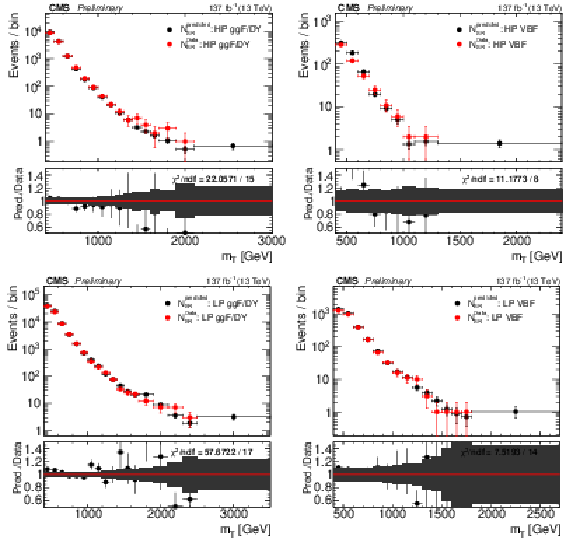
png pdf |
Figure 4:
Comparison of validation signal region background estimations and observations for the high-purity ggF/DY (top left), high-purity VBF (top right), low-purity ggF/DY (bottom left), and low-purity VBF (bottom right). The bottom panel shows the ratio of the estimated and the observed event yields. The hashed band represents the total uncertainty in the corresponding SR. |

png pdf |
Figure 4-a:
Comparison of validation signal region background estimations and observations for the high-purity ggF/DY (top left), high-purity VBF (top right), low-purity ggF/DY (bottom left), and low-purity VBF (bottom right). The bottom panel shows the ratio of the estimated and the observed event yields. The hashed band represents the total uncertainty in the corresponding SR. |

png pdf |
Figure 4-b:
Comparison of validation signal region background estimations and observations for the high-purity ggF/DY (top left), high-purity VBF (top right), low-purity ggF/DY (bottom left), and low-purity VBF (bottom right). The bottom panel shows the ratio of the estimated and the observed event yields. The hashed band represents the total uncertainty in the corresponding SR. |

png pdf |
Figure 4-c:
Comparison of validation signal region background estimations and observations for the high-purity ggF/DY (top left), high-purity VBF (top right), low-purity ggF/DY (bottom left), and low-purity VBF (bottom right). The bottom panel shows the ratio of the estimated and the observed event yields. The hashed band represents the total uncertainty in the corresponding SR. |

png pdf |
Figure 4-d:
Comparison of validation signal region background estimations and observations for the high-purity ggF/DY (top left), high-purity VBF (top right), low-purity ggF/DY (bottom left), and low-purity VBF (bottom right). The bottom panel shows the ratio of the estimated and the observed event yields. The hashed band represents the total uncertainty in the corresponding SR. |

png pdf |
Figure 5:
Distributions of mT for high-purity VBF (left) and ggF/DY (right) CR events after performing background-only fits. The last bin in the left (right) plot corresponds to the yields integrated above 2.3 TeV (3 TeV). The top panels of each plot show the post-fit prediction, represented by filled histograms, compared to observed yields, represented by black points. A VBF-produced (ggF-produced) 1 TeV graviton signal is shown in the left (right) plot, represented by the open red histogram. The blue hashed area represents the total uncertainty from the post-fit predicted event yield as a function of mT. The middle panels of each plot show the ratio of data and post-fit predictions in blue. Each plot's bottom panel shows the difference between the observed event yields and the post-fit predictions normalized by the quadrature sum of the statistical uncertainty of the observed yield and the total uncertainty from the post-fit prediction in each mT bin. |
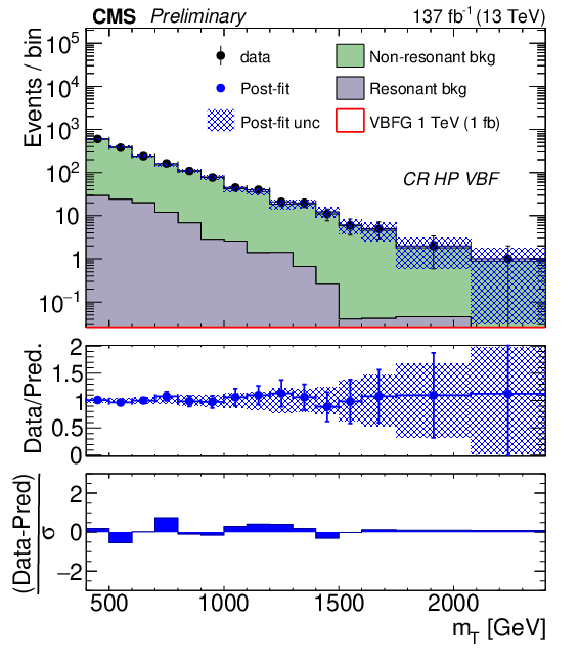
png pdf |
Figure 5-a:
Distributions of mT for high-purity VBF (left) and ggF/DY (right) CR events after performing background-only fits. The last bin in the left (right) plot corresponds to the yields integrated above 2.3 TeV (3 TeV). The top panels of each plot show the post-fit prediction, represented by filled histograms, compared to observed yields, represented by black points. A VBF-produced (ggF-produced) 1 TeV graviton signal is shown in the left (right) plot, represented by the open red histogram. The blue hashed area represents the total uncertainty from the post-fit predicted event yield as a function of mT. The middle panels of each plot show the ratio of data and post-fit predictions in blue. Each plot's bottom panel shows the difference between the observed event yields and the post-fit predictions normalized by the quadrature sum of the statistical uncertainty of the observed yield and the total uncertainty from the post-fit prediction in each mT bin. |
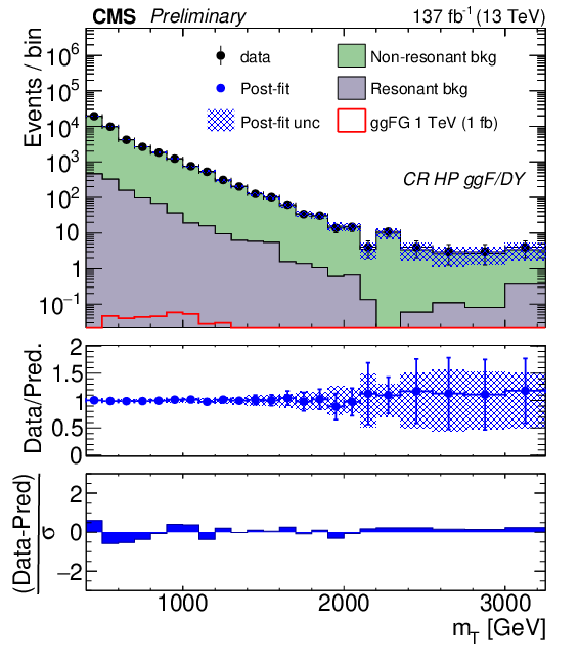
png pdf |
Figure 5-b:
Distributions of mT for high-purity VBF (left) and ggF/DY (right) CR events after performing background-only fits. The last bin in the left (right) plot corresponds to the yields integrated above 2.3 TeV (3 TeV). The top panels of each plot show the post-fit prediction, represented by filled histograms, compared to observed yields, represented by black points. A VBF-produced (ggF-produced) 1 TeV graviton signal is shown in the left (right) plot, represented by the open red histogram. The blue hashed area represents the total uncertainty from the post-fit predicted event yield as a function of mT. The middle panels of each plot show the ratio of data and post-fit predictions in blue. Each plot's bottom panel shows the difference between the observed event yields and the post-fit predictions normalized by the quadrature sum of the statistical uncertainty of the observed yield and the total uncertainty from the post-fit prediction in each mT bin. |

png pdf |
Figure 6:
Distributions of mT for low-purity VBF (left) and ggF/DY (right) CR events after performing background-only fits. The last bin in the left (right) plot corresponds to the yields integrated above 2.7 TeV (3.5 TeV). The top panels of each plot show the post-fit prediction, represented by filled histograms, compared to observed yields, represented by black points. A VBF-produced (ggF-produced) 1 TeV graviton signal is shown in the left (right) plot, represented by the open red histogram. The blue hashed area represents the total uncertainty from the post-fit predicted event yield as a function of mT. The middle panels of each plot show the ratio of data and post-fit predictions in blue. Each plot's bottom panel shows the difference between the observed event yields and the post-fit predictions normalized by the quadrature sum of the statistical uncertainty of the observed yield and the total uncertainty from the post-fit prediction in each mT bin. |
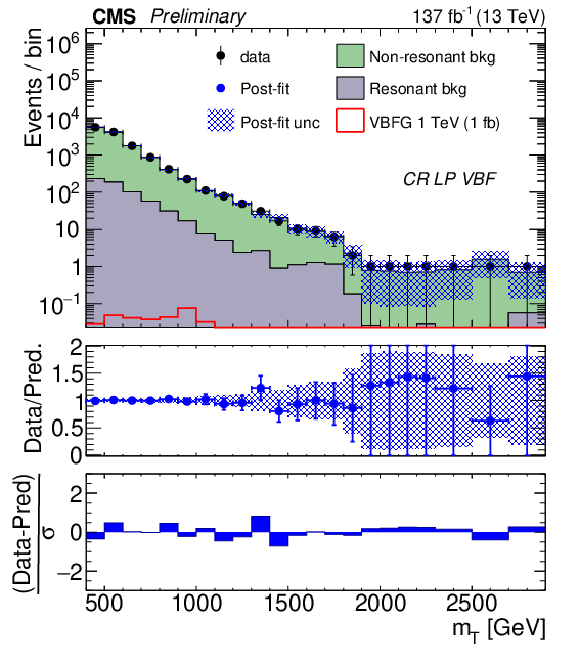
png pdf |
Figure 6-a:
Distributions of mT for low-purity VBF (left) and ggF/DY (right) CR events after performing background-only fits. The last bin in the left (right) plot corresponds to the yields integrated above 2.7 TeV (3.5 TeV). The top panels of each plot show the post-fit prediction, represented by filled histograms, compared to observed yields, represented by black points. A VBF-produced (ggF-produced) 1 TeV graviton signal is shown in the left (right) plot, represented by the open red histogram. The blue hashed area represents the total uncertainty from the post-fit predicted event yield as a function of mT. The middle panels of each plot show the ratio of data and post-fit predictions in blue. Each plot's bottom panel shows the difference between the observed event yields and the post-fit predictions normalized by the quadrature sum of the statistical uncertainty of the observed yield and the total uncertainty from the post-fit prediction in each mT bin. |

png pdf |
Figure 6-b:
Distributions of mT for low-purity VBF (left) and ggF/DY (right) CR events after performing background-only fits. The last bin in the left (right) plot corresponds to the yields integrated above 2.7 TeV (3.5 TeV). The top panels of each plot show the post-fit prediction, represented by filled histograms, compared to observed yields, represented by black points. A VBF-produced (ggF-produced) 1 TeV graviton signal is shown in the left (right) plot, represented by the open red histogram. The blue hashed area represents the total uncertainty from the post-fit predicted event yield as a function of mT. The middle panels of each plot show the ratio of data and post-fit predictions in blue. Each plot's bottom panel shows the difference between the observed event yields and the post-fit predictions normalized by the quadrature sum of the statistical uncertainty of the observed yield and the total uncertainty from the post-fit prediction in each mT bin. |

png pdf |
Figure 7:
Distribution of the predicted and observed event yields versus mT for high-purity VBF (right) and ggF/DY (left) signal region events. The last bin in each plot corresponds to the yields integrated above the penultimate bin. The top panels of each plot show the prediction based on a background-only fit to data, represented by filled histograms, compared to observed yields, represented by black points. A ggF-produced (VBF-produced) 1 TeV graviton signal is shown in the left (right) plot, represented by the open red histogram. The middle panels of each plot show the ratio of data and post-fit predictions in blue. The blue hashed area represents the total uncertainty from the post-fit predicted event yield as a function of mT. Each plot's bottom panel shows the difference between the observed event yields and the post-fit predictions normalized by the quadrature sum of the statistical uncertainty of the observed yield and the total uncertainty from the post-fit prediction in each mT bin. |

png pdf |
Figure 7-a:
Distribution of the predicted and observed event yields versus mT for high-purity VBF (right) and ggF/DY (left) signal region events. The last bin in each plot corresponds to the yields integrated above the penultimate bin. The top panels of each plot show the prediction based on a background-only fit to data, represented by filled histograms, compared to observed yields, represented by black points. A ggF-produced (VBF-produced) 1 TeV graviton signal is shown in the left (right) plot, represented by the open red histogram. The middle panels of each plot show the ratio of data and post-fit predictions in blue. The blue hashed area represents the total uncertainty from the post-fit predicted event yield as a function of mT. Each plot's bottom panel shows the difference between the observed event yields and the post-fit predictions normalized by the quadrature sum of the statistical uncertainty of the observed yield and the total uncertainty from the post-fit prediction in each mT bin. |
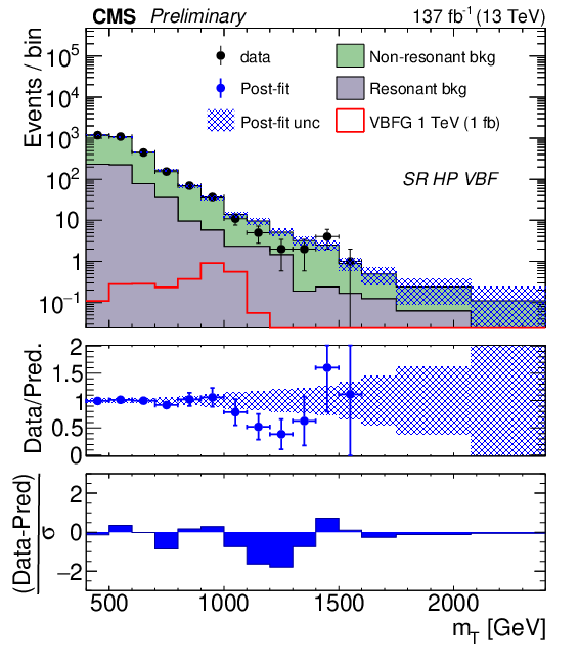
png pdf |
Figure 7-b:
Distribution of the predicted and observed event yields versus mT for high-purity VBF (right) and ggF/DY (left) signal region events. The last bin in each plot corresponds to the yields integrated above the penultimate bin. The top panels of each plot show the prediction based on a background-only fit to data, represented by filled histograms, compared to observed yields, represented by black points. A ggF-produced (VBF-produced) 1 TeV graviton signal is shown in the left (right) plot, represented by the open red histogram. The middle panels of each plot show the ratio of data and post-fit predictions in blue. The blue hashed area represents the total uncertainty from the post-fit predicted event yield as a function of mT. Each plot's bottom panel shows the difference between the observed event yields and the post-fit predictions normalized by the quadrature sum of the statistical uncertainty of the observed yield and the total uncertainty from the post-fit prediction in each mT bin. |

png pdf |
Figure 8:
Distribution of the predicted and observed event yields versus mT for low-purity VBF (right) and ggF/DY (left) signal region events. The last bin in each plot corresponds to the yields integrated above the penultimate bin. The top panels of each plot show the prediction based on a background-only fit to data, represented by filled histograms, compared to observed yields, represented by black points. A ggF-produced (VBF-produced) 1 TeV graviton signal is shown in the left (right) plot, represented by the open red histogram. The middle panels of each plot show the ratio of data and post-fit predictions in blue. The blue hashed area represents the total uncertainty from the post-fit predicted event yield as a function of mT. Each plot's bottom panel shows the difference between the observed event yields and the post-fit predictions normalized by the quadrature sum of the statistical uncertainty of the observed yield and the total uncertainty from the post-fit prediction in each mT bin. |

png pdf |
Figure 8-a:
Distribution of the predicted and observed event yields versus mT for low-purity VBF (right) and ggF/DY (left) signal region events. The last bin in each plot corresponds to the yields integrated above the penultimate bin. The top panels of each plot show the prediction based on a background-only fit to data, represented by filled histograms, compared to observed yields, represented by black points. A ggF-produced (VBF-produced) 1 TeV graviton signal is shown in the left (right) plot, represented by the open red histogram. The middle panels of each plot show the ratio of data and post-fit predictions in blue. The blue hashed area represents the total uncertainty from the post-fit predicted event yield as a function of mT. Each plot's bottom panel shows the difference between the observed event yields and the post-fit predictions normalized by the quadrature sum of the statistical uncertainty of the observed yield and the total uncertainty from the post-fit prediction in each mT bin. |

png pdf |
Figure 8-b:
Distribution of the predicted and observed event yields versus mT for low-purity VBF (right) and ggF/DY (left) signal region events. The last bin in each plot corresponds to the yields integrated above the penultimate bin. The top panels of each plot show the prediction based on a background-only fit to data, represented by filled histograms, compared to observed yields, represented by black points. A ggF-produced (VBF-produced) 1 TeV graviton signal is shown in the left (right) plot, represented by the open red histogram. The middle panels of each plot show the ratio of data and post-fit predictions in blue. The blue hashed area represents the total uncertainty from the post-fit predicted event yield as a function of mT. Each plot's bottom panel shows the difference between the observed event yields and the post-fit predictions normalized by the quadrature sum of the statistical uncertainty of the observed yield and the total uncertainty from the post-fit prediction in each mT bin. |
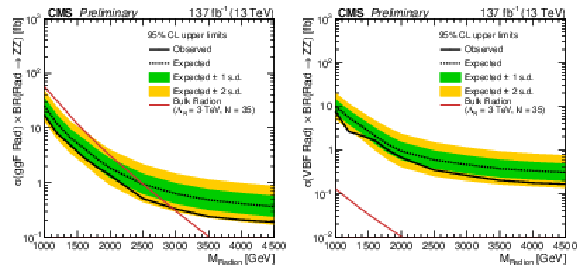
png pdf |
Figure 9:
Expected and observed 95% CL upper limits on the product of the radion (R) production cross section and the R→ZZ branching ratio versus the radion mass are shown as dashed and solid black lines, respectively. Green and yellow bands, respectively, represent the 68% and 95% intervals of expected limits. The red curve shows the theoretical radion production cross section times their ZZ branching ratio. The hashed red area represents the theoretical cross section uncertainty due to limited knowledge of PDFs and QCD scale choices. Limits and theory cross sections for ggF-produced radions are shown in the left figure, while the right figure shows the same for VBF-produced radions. |
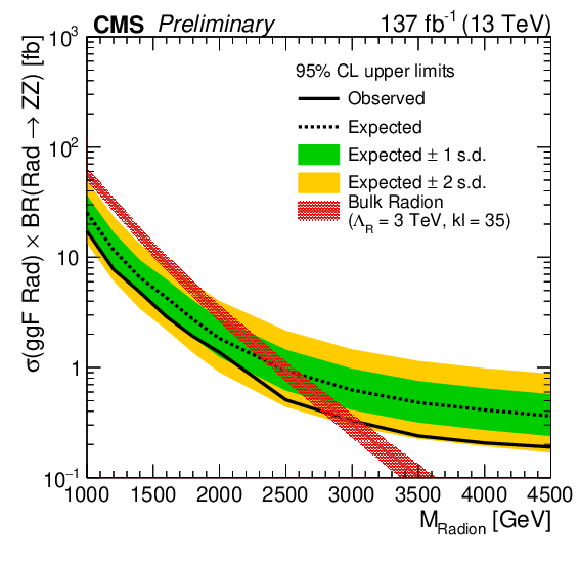
png pdf |
Figure 9-a:
Expected and observed 95% CL upper limits on the product of the radion (R) production cross section and the R→ZZ branching ratio versus the radion mass are shown as dashed and solid black lines, respectively. Green and yellow bands, respectively, represent the 68% and 95% intervals of expected limits. The red curve shows the theoretical radion production cross section times their ZZ branching ratio. The hashed red area represents the theoretical cross section uncertainty due to limited knowledge of PDFs and QCD scale choices. Limits and theory cross sections for ggF-produced radions are shown in the left figure, while the right figure shows the same for VBF-produced radions. |
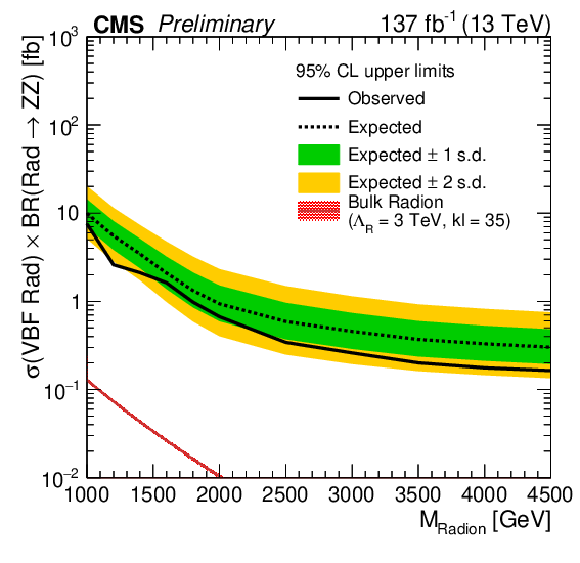
png pdf |
Figure 9-b:
Expected and observed 95% CL upper limits on the product of the radion (R) production cross section and the R→ZZ branching ratio versus the radion mass are shown as dashed and solid black lines, respectively. Green and yellow bands, respectively, represent the 68% and 95% intervals of expected limits. The red curve shows the theoretical radion production cross section times their ZZ branching ratio. The hashed red area represents the theoretical cross section uncertainty due to limited knowledge of PDFs and QCD scale choices. Limits and theory cross sections for ggF-produced radions are shown in the left figure, while the right figure shows the same for VBF-produced radions. |

png pdf |
Figure 10:
Expected and observed 95% CL upper limits on the product of the W' production cross section and the W′→WZ branching ratio versus the W' mass are shown as dashed and solid black lines, respectively. Green and yellow bands, respectively, represent the 68% and 95% intervals of the expected limit. The red curve shows the theoretical W' boson production cross section times their WZ branching ratio. Limits and theory cross sections for qˉq-produced (DY) W' bosons are shown in the left figure, while the right figure shows the same for VBF-produced W' bosons. |
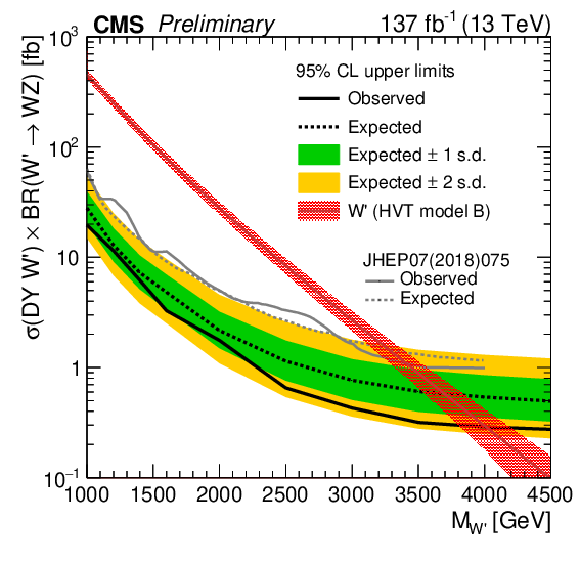
png pdf |
Figure 10-a:
Expected and observed 95% CL upper limits on the product of the W' production cross section and the W′→WZ branching ratio versus the W' mass are shown as dashed and solid black lines, respectively. Green and yellow bands, respectively, represent the 68% and 95% intervals of the expected limit. The red curve shows the theoretical W' boson production cross section times their WZ branching ratio. Limits and theory cross sections for qˉq-produced (DY) W' bosons are shown in the left figure, while the right figure shows the same for VBF-produced W' bosons. |
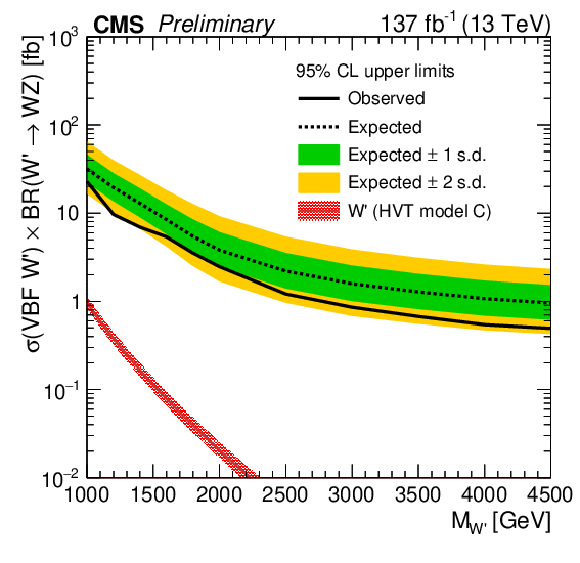
png pdf |
Figure 10-b:
Expected and observed 95% CL upper limits on the product of the W' production cross section and the W′→WZ branching ratio versus the W' mass are shown as dashed and solid black lines, respectively. Green and yellow bands, respectively, represent the 68% and 95% intervals of the expected limit. The red curve shows the theoretical W' boson production cross section times their WZ branching ratio. Limits and theory cross sections for qˉq-produced (DY) W' bosons are shown in the left figure, while the right figure shows the same for VBF-produced W' bosons. |
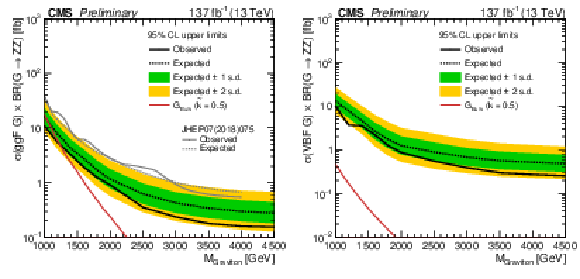
png pdf |
Figure 11:
Expected and observed 95% CL upper limits on the product of the graviton (G) production cross section and the G→ZZ branching ratio versus the graviton mass are shown as dashed and solid black lines, respectively. Green and yellow bands, respectively, represent 68% and 95% intervals of the expected limit. The red curve shows the theoretical graviton production cross section times their ZZ branching ratio. Limits and theory cross sections for ggF-produced gravitons are shown in the left figure, while the right figure shows the same for VBF-produced gravitons. |

png pdf |
Figure 11-a:
Expected and observed 95% CL upper limits on the product of the graviton (G) production cross section and the G→ZZ branching ratio versus the graviton mass are shown as dashed and solid black lines, respectively. Green and yellow bands, respectively, represent 68% and 95% intervals of the expected limit. The red curve shows the theoretical graviton production cross section times their ZZ branching ratio. Limits and theory cross sections for ggF-produced gravitons are shown in the left figure, while the right figure shows the same for VBF-produced gravitons. |
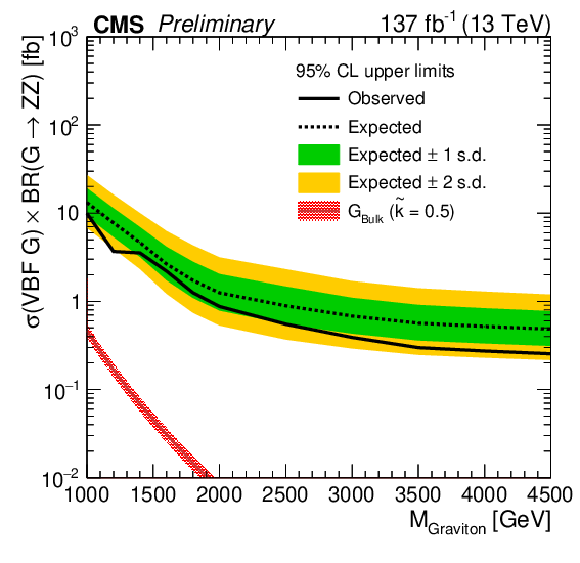
png pdf |
Figure 11-b:
Expected and observed 95% CL upper limits on the product of the graviton (G) production cross section and the G→ZZ branching ratio versus the graviton mass are shown as dashed and solid black lines, respectively. Green and yellow bands, respectively, represent 68% and 95% intervals of the expected limit. The red curve shows the theoretical graviton production cross section times their ZZ branching ratio. Limits and theory cross sections for ggF-produced gravitons are shown in the left figure, while the right figure shows the same for VBF-produced gravitons. |
| Tables | |

png pdf |
Table 1:
Summary of systematic uncertainties (in%) for SM backgrounds. Columns two and three tabulate the representative size of effects on α in the VBF and ggF/DY events categories, respectively. Columns four through seven tabulate the typical size of effects on the prediction of resonant background yields in the VBF SR, VBF CR, ggF/DY SR, and ggF/DY CR, respectively. |
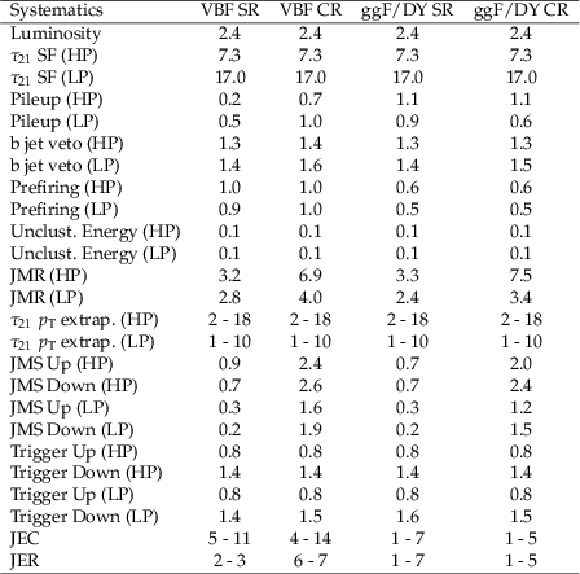
png pdf |
Table 2:
Summary of the typical size of systematic uncertainties (in %) on the predicted signal yields in various regions. |
| Summary |
| A search is presented for new bosonic states decaying to either a pair of Z bosons or a Z boson and a W boson. The analyzed final state requires large missing transverse momentum and one high-momentum, large-radius jet. Large-radius jets are required to have a mass consistent with either a Z or W boson. Events are categorized based on the presence of large-radius jets passing high-purity and low-purity substructure requirements. Events are also categorized based on the presence or absence of high momentum jets in the forward region of the detector. Forward jets distinguish gluon-gluon fusion (ggF) and weak vector boson fusion (VBF) production mechanisms. The dominant SM backgrounds are estimated using an extrapolation method from data control regions. No deviation between SM expectation and data is found, and 95% confidence level (CL) upper limits are set on the product of the production cross section and branching ratio for several signal models. A lower limit of 3.0 TeV is set on the mass of ggF-produced radions. The mass exclusion limit for qˉq-produced W' bosons is found to be 4.0 TeV. The mass exclusion limit for ggF-produced gravitons is found to be 1.2 TeV. No mass exclusion limits are set for models in which resonances are exclusively produced through VBF. At 95% CL, upper limits on the product of the VBF production cross section and X→VZ branching ratio range between 0.2 fb and 20 fb. |
| References | ||||
| 1 | L. Randall and R. Sundrum | Large mass hierarchy from a small extra dimension | Physical Review Letters 83 (Oct, 1999) 3370 | hep-ph/9905221 |
| 2 | L. Randall and R. Sundrum | An alternative to compactification | Physical Review Letters 83 (Dec, 1999) 4690 | hep-th/9906064 |
| 3 | D. Pappadopulo, A. Thamm, R. Torre, and A. Wulzer | Heavy vector triplets: Bridging theory and data | JHEP 09 (2014) 060 | 1402.4431 |
| 4 | K. Agashe et al. | LHC signals for warped electroweak charged gauge bosons | PRD 80 (2009) 075007 | 0810.1497 |
| 5 | K. Agashe et al. | LHC signals for coset electroweak gauge bosons in warped/composite PGB higgs models | PRD 81 (2010) 096002 | 0911.0059 |
| 6 | K. Agashe et al. | LHC signals for warped electroweak neutral gauge bosons | PRD 76 (2007) 115015 | 0709.0007 |
| 7 | N. Arkani-Hamed et al. | The minimal moose for a little Higgs | JHEP 08 (2002) 021 | hep-ph/0206020 |
| 8 | N. Arkani-Hamed, A. G. Cohen, E. Katz, and A. E. Nelson | The littlest Higgs | JHEP 07 (2002) 034 | hep-ph/0206021 |
| 9 | G. Burdman, M. Perelstein, and A. Pierce | Large hadron collider tests of a little Higgs model | PRL 90 (2003) 241802 | hep-ph/0212228 |
| 10 | K. Agashe, H. Davoudiasl, G. Perez, and A. Soni | Warped gravitons at the CERN LHC and beyond | PRD 76 (Aug, 2007) 036006 | hep-ph/0701186 |
| 11 | A. L. Fitzpatrick, J. Kaplan, L. Randall, and L.-T. Wang | Searching for the Kaluza-Klein graviton in bulk RS models | JHEP 09 (2007) 013 | hep-ph/0701150 |
| 12 | ATLAS Collaboration | Searches for heavy ZZ and ZW resonances in the ℓℓqq and ννqq final states in pp collisions at √s= 13 TeV with the ATLAS detector | JHEP 03 (2018) 009 | 1708.09638 |
| 13 | CMS Collaboration | Search for a heavy resonance decaying into a Z boson and a vector boson in the ν¯νq¯q final state | JHEP 07 (2018) 075 | CMS-B2G-17-005 1803.03838 |
| 14 | J. Alwall et al. | The automated computation of tree-level and next-to-leading order differential cross sections, and their matching to parton shower simulations | JHEP 07 (2014) 079 | 1405.0301 |
| 15 | R. Frederix and S. Frixione | Merging meets matching in MC@NLO | JHEP 12 (2012) 061 | 1209.6215 |
| 16 | J. Alwall et al. | Comparative study of various algorithms for the merging of parton showers and matrix elements in hadronic collisions | EPJC 53 (2008) 473 | 0706.2569 |
| 17 | P. Artoisenet, R. Frederix, O. Mattelaer, and R. Rietkerk | Automatic spin-entangled decays of heavy resonances in Monte Carlo simulations | JHEP 03 (2013) 015 | 1212.3460 |
| 18 | P. Nason | A new method for combining NLO QCD with shower Monte Carlo algorithms | JHEP 11 (2004) 040 | hep-ph/0409146 |
| 19 | S. Frixione, P. Nason, and C. Oleari | Matching NLO QCD computations with parton shower simulations: the POWHEG method | JHEP 11 (2007) 070 | 0709.2092 |
| 20 | S. Alioli, P. Nason, C. Oleari, and E. Re | A general framework for implementing NLO calculations in shower Monte Carlo programs: the POWHEG BOX | JHEP 06 (2010) 043 | 1002.2581 |
| 21 | S. Alioli, P. Nason, C. Oleari, and E. Re | NLO single-top production matched with shower in POWHEG: s- and t-channel contributions | JHEP 09 (2009) 111 | 0907.4076 |
| 22 | E. Re | Single-top Wt-channel production matched with parton showers using the POWHEG method | EPJC 71 (2011) 1547 | 1009.2450 |
| 23 | T. Sjostrand et al. | An introduction to PYTHIA 8.2 | CPC 191 (2015) 159 | 1410.3012 |
| 24 | CMS Collaboration | Event generator tunes obtained from underlying event and multiparton scattering measurements | EPJC 76 (2016), no. 3, 155 | CMS-GEN-14-001 1512.00815 |
| 25 | CMS Collaboration | Extraction and validation of a new set of CMS PYTHIA8 tunes from underlying-event measurements | EPJC 80 (2020), no. 1, 4 | CMS-GEN-17-001 1903.12179 |
| 26 | NNPDF Collaboration | Parton distributions for the LHC Run II | JHEP 04 (2015) 040 | 1410.8849 |
| 27 | NNPDF Collaboration | Parton distributions from high-precision collider data | EPJC 77 (2017) 663 | 1706.00428 |
| 28 | T. Melia, P. Nason, R. Rontsch, and G. Zanderighi | W+W−, WZ and ZZ production in the POWHEG BOX | JHEP 11 (2011) 078 | 1107.5051 |
| 29 | M. Beneke, P. Falgari, S. Klein, and C. Schwinn | Hadronic top-quark pair production with NNLL threshold resummation | NPB 855 (2012) 695 | 1109.1536 |
| 30 | M. Cacciari et al. | Top-pair production at hadron colliders with next-to-next-to-leading logarithmic soft-gluon resummation | PLB 710 (2012) 612 | 1111.5869 |
| 31 | P. Barnreuther, M. Czakon, and A. Mitov | Percent level precision physics at the Tevatron: First genuine NNLO QCD corrections to qˉq→tˉt+X | PRL 109 (2012) 132001 | 1204.5201 |
| 32 | M. Czakon and A. Mitov | NNLO corrections to top-pair production at hadron colliders: the all-fermionic scattering channels | JHEP 12 (2012) 054 | 1207.0236 |
| 33 | M. Czakon and A. Mitov | NNLO corrections to top pair production at hadron colliders: the quark-gluon reaction | JHEP 01 (2013) 080 | 1210.6832 |
| 34 | M. Czakon, P. Fiedler, and A. Mitov | Total top-quark pair-production cross section at hadron colliders through O(αS4) | PRL 110 (2013) 252004 | 1303.6254 |
| 35 | R. Gavin, Y. Li, F. Petriello, and S. Quackenbush | W physics at the LHC with FEWZ 2.1 | CPC 184 (2013) 208 | 1201.5896 |
| 36 | R. Gavin, Y. Li, F. Petriello, and S. Quackenbush | FEWZ 2.0: A code for hadronic Z production at next-to-next-to-leading order | CPC 182 (2011) 2388 | 1011.3540 |
| 37 | J. M. Lindert et al. | Precise predictions for V+jets dark matter backgrounds | EPJC 77 (2017), no. 12, 829 | 1705.04664 |
| 38 | S. Bolognesi et al. | On the spin and parity of a single-produced resonance at the LHC | PRD 86 (2012) 095031 | 1208.4018 |
| 39 | A. Oliveira | Gravity particles from warped extra dimensions, predictions for LHC | (Mar, 2014) | 1404.0102 |
| 40 | CMS Collaboration | Performance of the CMS Level-1 trigger in proton-proton collisions at √s= 13 TeV | JINST 15 (2020) P10017 | CMS-TRG-17-001 2006.10165 |
| 41 | CMS Collaboration | The CMS trigger system | JINST 12 (2017) P01020 | CMS-TRG-12-001 1609.02366 |
| 42 | CMS Collaboration | The CMS experiment at the CERN LHC | JINST 3 (2008) S08004 | CMS-00-001 |
| 43 | CMS Collaboration | Particle-flow reconstruction and global event description with the CMS detector | JINST 12 (2017) P10003 | CMS-PRF-14-001 1706.04965 |
| 44 | M. Cacciari, G. P. Salam, and G. Soyez | The anti-kt jet clustering algorithm | JHEP 04 (2008) 063 | 0802.1189 |
| 45 | M. Cacciari, G. P. Salam, and G. Soyez | FastJet user manual | EPJC 72 (2012) 1896 | 1111.6097 |
| 46 | CMS Collaboration | Performance of Electron Reconstruction and Selection with the CMS Detector in Proton-Proton Collisions at √s= 8 TeV | JINST 10 (2015), no. 06, P06005 | CMS-EGM-13-001 1502.02701 |
| 47 | CMS Collaboration | Performance of the CMS muon detector and muon reconstruction with proton-proton collisions at √s= 13 TeV | JINST 13 (2018) P06015 | CMS-MUO-16-001 1804.04528 |
| 48 | K. Rehermann and B. Tweedie | Efficient identification of boosted semileptonic top quarks at the LHC | JHEP 03 (2011) 059 | 1007.2221 |
| 49 | CMS Collaboration | Performance of photon reconstruction and identification with the CMS detector in proton-proton collisions at √s= 8 TeV | JINST 10 (2015) P08010 | CMS-EGM-14-001 1502.02702 |
| 50 | CMS Collaboration | Jet energy scale and resolution in the CMS experiment in pp collisions at 8 TeV | JINST 12 (2017) P02014 | CMS-JME-13-004 1607.03663 |
| 51 | CMS Collaboration | Pileup mitigation at CMS in 13 TeV data | JINST 15 (2020) P09018 | CMS-JME-18-001 2003.00503 |
| 52 | D. Bertolini, P. Harris, M. Low, and N. Tran | Pileup Per Particle Identification | JHEP 10 (2014) 059 | 1407.6013 |
| 53 | CMS Collaboration | Jet performance in pp collisions at √s= 7 TeV | CDS | |
| 54 | CMS Collaboration | Jet algorithms performance in 13 TeV data | CMS-PAS-JME-16-003 | CMS-PAS-JME-16-003 |
| 55 | M. Dasgupta, A. Fregoso, S. Marzani, and G. P. Salam | Towards an understanding of jet substructure | JHEP 09 (2013) 029 | 1307.0007 |
| 56 | A. J. Larkoski, S. Marzani, G. Soyez, and J. Thaler | Soft Drop | JHEP 05 (2014) 146 | 1402.2657 |
| 57 | J. Thaler and K. Van Tilburg | Identifying boosted objects with N-subjettiness | JHEP 03 (2011) 015 | 1011.2268 |
| 58 | CMS Collaboration | Identification of heavy-flavour jets with the CMS detector in pp collisions at 13TeV | JINST 13 (2018) P05011 | CMS-BTV-16-002 1712.07158 |
| 59 | CMS Collaboration | Performance of missing transverse momentum reconstruction in proton-proton collisions at √s= 13TeV using the CMS detector | JINST 14 (2019), no. 07, P07004 | CMS-JME-17-001 1903.06078 |
| 60 | A. L. Read | Presentation of search results: the CLs technique | JPG 28 (2002) 2693 | |
| 61 | G. Cowan, K. Cranmer, E. Gross, and O. Vitells | Asymptotic formulae for likelihood-based tests of new physics | EPJC 71 (2011) 1554 | 1007.1727 |

|
Compact Muon Solenoid LHC, CERN |

|

|

|

|

|

|